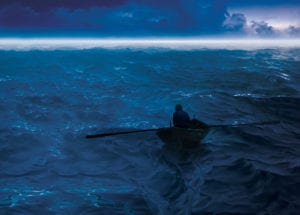By Daniel de la Calle
The screening at Maloka and the countless interviews in Bogotá couldn’t have gone any better. Some sort of miracle, some magic must have turned my pumpkin backpack into the Ocean Acidification ambassador’s golden chariot (caught up in the worst traffic jams ever, though!) and I was welcomed like royalty, asked for hours by journalists, interviewed on radio shows, by inquisitive citizens and environmentalists about the film and the state of our oceans.
What the city of Bogotá lacks in charms and warmth the people certainly make up with contagious enthusiasm, cordiality, pure interest and politeness. Colombians, Bogotanos at least, strike me as hard working, serious, punctual and unnecessarily apologetic people. They feel an urge to talk about the dreadful 80s and 90s, about the violence those days, the killings, the bombings and the plague of corruption that rotted their natural desire for peace and progress. It is as if they felt that it was their personal fault that the rest of the world looks their way with disdain and fear, as if each one of them is individually responsible for how they have been stigmatized. I think few places need more desperately a worldwide PR campaign than Colombia. Bogotanos are certainly the first to warn you of the many dangers, the first to list the places you cannot wander around at night and the ones you never step into, but everyone also agrees that things are not the way they used to, that they have improved. On my way to the airport yesterday morning my loyal cab driver Ángel, the man I spent so many hours with, explained in his subdued voice: “The problem in the 80s and 90s was that the cocaine producers were also involved in all the distribution abroad. The business was in the hands of a couple drug lords that had too much power and felt invincible, stopped at nothing; they fought each other, fought the government, fought the people. Over these past 15 years things have changed. There are many small producers now, and after all the brutal violence and hunt down they have decided it is ok to have less power but also enjoy quieter life. They do not want that incessant war within Colombia, so they passed the distribution business to Mexico. And look how things are there now, like here 25 years ago. Well, almost.”

The way things looked during most of my time in Bogotá, wih Ángel.
Thanks to the FESTIVER staff, Colombia’s first environmental film festival that A Sea Change will be a part of in the early fall, I toured all the major newspapers and news agencies and did numerous phone interviews for radio shows. I am not very good with this sort of work, bore myself way too easily if I say the same things and crack the same jokes, so I end up changing my lines and “routine” at every screening, on live interviews, with that young journalist obsessed with Alaska. Unfortunately, the message does not always come as clear or interesting as as tested, rehearsed and memorized version and this pursue of the new leaves me exhausted. But I do not want to sound negative, we could have never dreamed of a coverage as exhaustive as this, that people would show such interest and show for screenings they way the have.
The Thursday event organized by Instituto Humboldt at MALOKA

Their invitation to the screening
was in the early evening. Half an hour before the start I walked up the steps to the square and faced a line of people that encircled its iconic dome. They were all there to watch A Sea Change! The room filled up, every sit was taken and we still had to turn 30 people down. The audience was mostly made of young Bogotanos, men and women that had never heard about Ocean Acidification but were passionate about the sea and ecology, with a few scientists and a dozen members of environmental organizations to pepper the sancocho (traditional Colombian stew). Although Bogotá is hundreds of miles away from the sea Colombia is after all the only South American country with both Pacific and Caribbean coasts and vast coral reefs.

One of the few things leisurely things I squeezed into this Ocean Acidification filled agenda was a brief visit to the Museo del Oro. Colombia’s finest museum is solely dedicated to gold, to its geological origin and history with human kind, to its extraction and the different techniques the first goldsmiths applied and its use as adornment with symbolic power by pre-Columbian civilizations. Although I have never shown much interest in shiny metals it was a blinding and intriguing experience (where does our passion for metals and gems come from?), one that spoke of a past eons away from complex contemporary Colombia.

A winged gold fish at the Museo del Oro

